|
Telephone kiosks and payphones
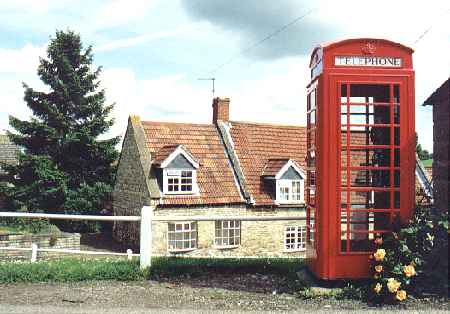 |
|
One of the
traditional red telephone kiosks in the main street at Castle
Bytham |
We take the telephone
for granted today and not only do most homes have one but millions of people also carry a mobile in their pocket or handbag. The ubiquity of this communications facility is part of our way of life but it was not always so. During
the early part of the 20th century, most people depended on the public call box, sometimes a mile or more away, to summon the doctor or the fire brigade in times of emergency, or to make that important call for business or domestic reasons. The sight of someone huddled inside the telephone box with a pile of pennies and a bundle of documents while others waited impatiently outside for their turn was a common one and lengthy queues often built up to use what was probably the only telephone in the locality.
The traditional red telephone boxes, made of cast iron and individually date stamped, were the property of the Crown and embossed with a crown motif on each side below the domed roof. Their popularity and usefulness was such that they soon became one of the instantly recognisable symbols of Britain but unfortunately they are less numerous in our towns and villages these days since thousands were replaced by the plain Perspex payphone booths in the 1980s and early 1990s.
The familiar red kiosk known as the K6 was introduced to commemorate the Silver Jubilee of King George V in May 1935 and it soon became known as the Jubilee Kiosk. It was designed by the architect Sir Giles Gilbert Scott (1880-1960) whose work on Liverpool's Anglican Cathedral, Cambridge University Library and Battersea Power Station, was already well known. Scott is thought to have been inspired for his design by the tomb of Sir John Soane (1753-1837), one of the greatest British architects of all time who was responsible for the Bank of England and Dulwich Picture Gallery. The tomb in St Pancras churchyard, London, which he originally designed for his wife, is itself a remarkable monument and one of only two in the city which is listed as of Grade I architectural importance but despite this, it is at present in a dismal state of overgrowth and neglect.
There had been previous versions of the telephone box but the Jubilee model became the first genuinely standard kiosk to be installed all over the country. Under the Jubilee Concession, introduced as part of that year's celebrations, kiosks were to be provided in every town or village with a post office regardless of cost and as a result of this scheme, over 8,000 new kiosks were installed, adding impetus to the spread of K6. In the following year, a Tercentenary Concession was introduced under which the Post Office undertook to install a kiosk on request almost anywhere provided the local authority agreed to pay the normal subscription of £4 a year for a period of five years and this scheme remained in force until 1949 and led to another 1,000 K6 boxes being introduced. A further arrangement known as the Rural Allocation Scheme was then introduced and this brought more kiosks to country areas whether they were likely to be profitable or not and so the telephone was brought within reach of everyone.
The red kiosk became extremely popular, especially in the countryside where villagers took pride in its appearance, cleaning it out every week, polishing the windows and in some cases, even adding curtains and vases of flowers to delight the occasional callers who stopped to use it while the "Press Button A and Button B" mechanism needed to make a call became the butt of music hall jokes and eventually part of the language.
The example shown above is in the High Street at Castle Bytham, near Bourne, beautifully preserved with a fresh coat of red paint and roses growing round the door, with the Old Bakehouse in Heathcote Road in the background, and perfectly in tune with its surroundings in this ancient village.
The Jubilee Kiosk is perhaps the best remembered of Giles Gilbert Scott's work, even though he supervised the rebuilding of the House of Commons after World War II, and to this day it is fondly regarded as a typical British landmark. The K6 survived the introduction of Numbers 7 and 8 until the KX 100-400 series of payphone booths arrived and thousands of the old K6 models were sold off, many fetching £200 and £300 each. Some were scrapped but many more were put to a variety of imaginative and bizarre uses by their new private owners. Millionaires in Hong Kong had them shipped out and installed in their homes as showers, producers acquired them to add authenticity to their film sets, a night club in Mexico City installed several and some have also found a home in Dubai, the second largest of the seven United Arab Emirates. There are also one
or two to be found in the gardens around Bourne while the Baytree Garden Centre at Weston, near Spalding, has half a dozen because the owner discovered that they were the perfect place to grow geraniums. Others went to the United States and businessmen at Cape Cod, Massachusetts, snapped up several as features for a shopping mall.
The affection of many Americans for these telephone boxes is quite apparent. John Hughes, who lives at Forth Worth in Texas, has fond memories of serving over here with the United States Air Force as a young man during the Second World War and he remembers them as one of the most endearing features of our street scene.
"Walking through Leicester on my first leave in town, I noticed this bright red, box-like structure and wondered what it could
be", he said. "Curious, I ambled closer, looked up and saw the word 'Telephone' near the top and some kind of symbol engraved below it. I peeked inside, walked around it and rubbed my hands over the paint. There must have been fifteen coats at least on it and I thought that the British must really like red! At that moment I wished I could have stepped inside and telephoned home but I walked away and looked back thinking that red paint was not such a bad idea after all. It sticks out like a sore thumb but least people can see it."
The Americans were among the many people who complained about the decision by British Telecom to phase out the old kiosks saying that they missed them when visiting this country. In fact, there were so many protests from at home and abroad that the programme of replacing them was revised and the policy changed to retain and even reintroduce the red boxes and they have since been put back in several places including Central London, down the Mall and around the back of Buckingham Palace. The K6 is now a registered design of British Telecom and from November 1997, the kiosks have also been licensed for use by competitors.
Nevertheless, many have been permanently lost but despite this, British Telecom reported in 1999 that there were still over 15,000 of these old style telephone boxes in heritage sites and, working with the Department of the Environment and English Heritage, more than 1,000 K6 kiosks were identified as being of special architectural and historical interest, mainly because they were near existing listed buildings or in attractive town and country locations. British Telecom has now pledged that the vast majority of these telephone boxes will be maintained until they are no longer viable and so another little slice of our heritage has been preserved by the will of the people.
Payphones
The familiar red kiosks were replaced with payphones
from 1980, boxes of plain Perspex and steel, but they lasted only until 2004
when British Telecom decided that as a result of changing habits and the
introduction of the mobile phone, they too had outlived their usefulness and
began removing them. Constant vandalism and the soaring cost of maintenance
played its part in their exit from the street scene.
By May 2008, all but four had disappeared from the town's streets, those in
Churchill Avenue and Northfields which were due to be phased out by the end of
the year, and two in the town centre which were being used regularly and will
remain for the time being.
Those to be axed were among a total of 72 due to be removed across the South
Kesteven district because according to BT figures they have declined in usage
following the introduction of mobile phones, making the majority unprofitable with
a continuing decline in the number of calls made. A spokesman for the company
said that although it was committed to providing a payphone service, the
evidence was that it was becoming less popular with the public. He added:
"Over the years, as usage has declined, BT has been constantly reviewing and
where necessary rationalising the service in order to meet demand. But almost
60 per cent are unprofitable with almost 6,000 phones making less than one
call a month. Payphone usage has halved in the last two years and calls are
still declining at the rate of 20 per cent a year. Any removal of unprofitable
phones is carried out in strict adherence to Ofcom guidelines and where
appropriate, with the consent of the local communities."
Some members expressed misgivings when the cut back was
discussed by Bourne Town Council on Tuesday 13th May 2008 on the grounds that
elderly people may not have access to the telephone as a result but Councillor
John Smith told the meeting: "Payphones are very little used these days
because of the coming of mobile phones. I am sure that anyone needing to use a
phone can find someone to help them. It is no longer economical to provide
payphones and it is going to be costly if we have to subsidise them."
|
PAYPHONES TARGETED |
|
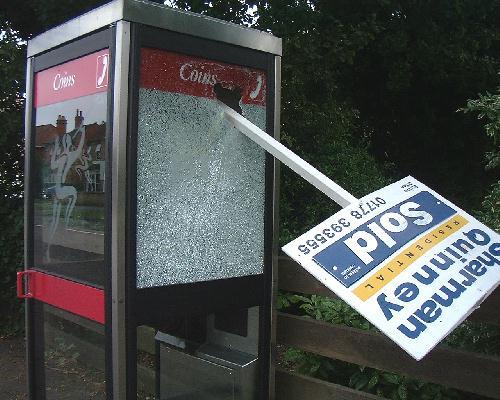 |
|
Payphones have been a particular target for vandals in Bourne. The
box above in North Road was wrecked three times, firstly during the August Bank Holiday
weekend in 2002 and after being repaired by British Telecom, it
was damaged again the following month (below left) and again in
September 2003 when a traffic cone was used as a battering ram
(bottom picture). Another kiosk round the corner in Northfields
was also vandalised in September 2002 (below right). The damage
became so repetitive at kiosks throughout the town that in 2004,
British Telecom began to phase them out, a decision also
influenced by the widespread use of mobile phones Estate
agents' signs are also repeatedly damaged and rarely a weekend
goes by without one or two being ripped up and tossed around the
road, or even worse, as is illustrated above. |
|
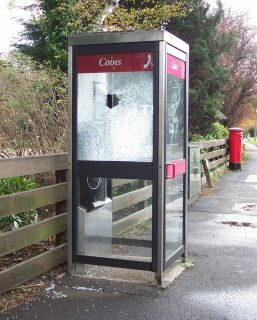 |
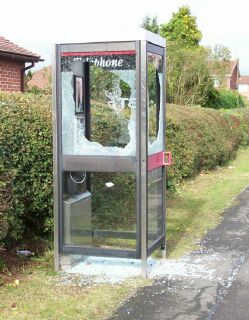 |
|
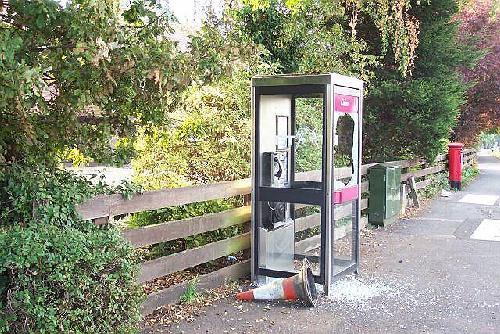 |
REVISED MAY 2008

Go to:
Main Index Villages
Index
|




